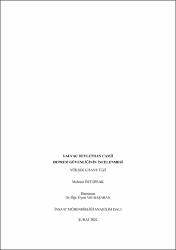Yalvaç Devlethan Camii deprem güvenliğinin incelenmesi
Özet
Ülkemizde yüz yıllardır, cami, türbe, köprü ve han gibi pek çok yapı inşa edilmiş ve bu kültürel miraslarımızın çoğu günümüze kadar ulaşmıştır. Bu yapıların gelecek nesillere aktarılması için gerekli önemlerin alınmalıdır. Aktif fay hatlarının bulunduğu topraklarımızda, deprem tehlikesi altındaki bu tarihi yapıların sismik performansları belirlenmelidir. Bu tür yapıların deprem performanslarının belirlenmesi zor ve uzmanlık gerektiren aşamalardan oluşmakla birlikte gerçeğe yakın yapı modelinin oluşturulması önemlidir. Bu tez çalışmasında, yapım tarihi 1400’lü yıllara dayanan Isparta ilinin Yalvaç ilçe merkezinde bulunan Devlethan Camii’nin deprem güvenliği araştırılmıştır. Caminin, Antalya Kültür Varlıklarını Koruma Bölge Kurulu Müdürlüğünden temin edilen röleve projeleri yerinde kontrol edildikten sonra üç boyutlu modeli SAP2000 programında oluşturulmuştur. Düşey yük ve deprem yükleri etkisi altında sonlu elemanlar yöntemi kullanılarak yapılan analizler neticesinde yapıda oluşan maksimum basınç, maksimum kayma gerilmesi ve yer değiştirme değerleri elde edilmiştir. Elde edilen sonuçlar değerlendirilerek yapının sismik performansı yorumlanmıştır. Many buildings such as mosques, tombs, bridges and inns have been built in our country for hundreds of years, and most of these cultural heritages have survived to the present day. Necessary measures should be taken in order to pass these structures on to future generations. The seismic performances of these historical structures under earthquake risk should be determined in our lands where active fault lines are located. Although determining the earthquake performance of such structures consists of stages that are difficult and require expertise, it is important to create a realistic building model. In this thesis, the earthquake safety of Devlethan Mosque, which is located in Yalvaç district center of Isparta province, whose construction date dates back to 1400s, has been investigated. The three-dimensional model of the mosque was created in the SAP2000 program after the survey projects obtained from the Antalya Regional Board for Conservation of Cultural Heritage were checked on site. As a result of the analysis made using the finite element method under the effect of vertical load and earthquake loads, the values of maximum pressure, maximum shear stress and displacement occurred in the structure were obtained. The seismic performance of the structure has been interpreted by evaluating the obtained results.
Bağlantı
https://hdl.handle.net/11630/8639Koleksiyonlar
- Yüksek Lisans Tezleri [890]



















